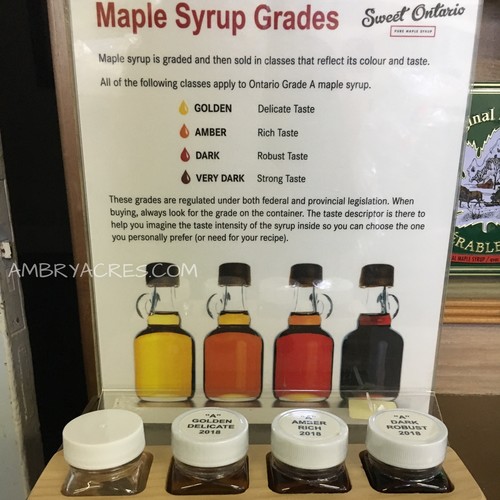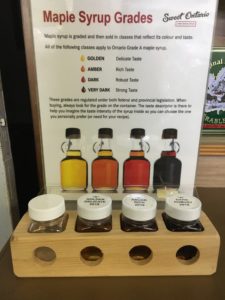Different Grades of Maple Syrup are in place to differenitate between the tastes and colour. The difference between maple syrups is strictly colour and the intensity of its maple flavour
Since we began our journey of producing maple syrup on our farm consistently in 2018, we have discussed this popular questions. “Which syrup is better, amber or dark?” or “What is the difference between your syrup and the one sold at the large grocery store?” Resulting in that this is a personal taste and choice.
We find comfort in knowing what’s in the food that we eat and serve in our home. We understand that when buying maple syrup directly from the farm, the customer can fully understand the process that was followed by the producer. All maple syrup is produced from the collection of sap from the maple tree then the water in the sap is boiled off until the sugar content reaches 66%. Although, every maple syrup farm is set up differently. As a result, some producers use a reverse osmosis and some do not. So, this is one factor that can lead into the production of very dark syrup.
A standardized grading system is in place to expand domestic and international markets. Consequently, we refer and follow these regulations:
Ontario Maple Syrup Regulations
The production of maple syrup and related products in Ontario is subject to regulations administered by the Ontario Ministry of Agriculture, Food and Rural Affairs. The applicable regulation is
Ontario Regulation 119/11: PRODUCE, HONEY AND MAPLE PRODUCTS, under Food Safety and Quality Act, 2001, S.O. 2001, c. 20
Grading and Colour Classification
Maple syrup being sold must be graded and classified for colour by the producer and shall be graded as follows:
2. Grades and Grade Names –
There are two grades of maple syrup that is not imported
Canada Grade A
3. Maple syrup graded “Canada Grade A” must be maple syrup that
- (a) has a minimum soluble solids content of 66% and a maximum soluble solids content of 68.9% as determined by a refractometer or hydrometer at 20°C;
- (b) is free from fermentation;
- (c) is uniform in colour and free from sediment and any cloudiness or turbidity;
- (d) has a colour class, as determined in accordance with section 5; and
- (e) has a maple flavour characteristic of its colour class and is free from any objectionable odour or taste.
Canada Processing Grade
4. Maple syrup graded “Canada Processing Grade” must be maple syrup that
- (a) has a minimum soluble solids content of 66% and a maximum soluble solids content of 68.9% as determined by a refractometer or hydrometer at 20°C; and
- (b) does not meet the requirements of paragraphs 3(c) to (e).
There is a colour classification system now in use by most maple syrup producers. Colour classification shall be according to Item 5 in the regulations, as follows:
Colour Classes of Canada Grade A Maple Syrup
5. (1) Canada Grade A maple syrup has the colour class set out in Column 1 of an item of the Table of Colour Classes of Canada Grade A Maple Syrup if it has the ability to transmit light, expressed as a percentage that is set out in Columns 2 and 3 of that item.
(2) The ability of Canada Grade A maple syrup to transmit light must be determined by means of
- (a) a spectrophotometer using matched square optical cells having a 10 mm light path at a wavelength of 560 nm, the colour values being expressed in per cent of light transmission as compared to A.R. Glycerol fixed at 100% transmission; or
- (b) a visual glass comparator, the optical specifications of which correspond to the method described in paragraph (a).





